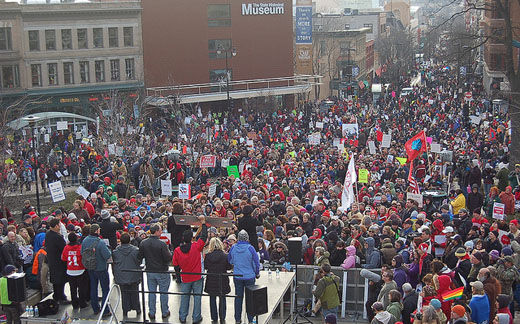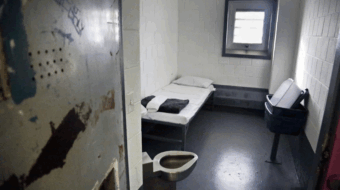
It was only one year ago, Jan. 3, 2011, when Scott Walker was inaugurated as the 45th Governor of the State of Wisconsin. In just a few months, he would undo 50 years of progress and Wisconsin tradition.
Citing the current economic crisis as well as the state’s deficit, Walker proposed a state budget that stripped workers of their collective bargaining rights. He made no effort to rectify this supposed cost saving proposal with the rest of his budget that included $2.3 billion in tax cuts for corporations over the next 10 years.
A stunned public reacted immediately. For weeks there were what seemed to be an endless parade of pickets circling the Capitol building in Madison, like planets around the sun. Teachers and students walked out of classrooms to lend their voices to the pro-worker chorus and carried signs such as, “I’m not the enemy, I’m a librarian.”
On each corner of the Capitol Square stood International Brotherhood of Teamsters semi-trailers. Firefighters blared Irish “war pipes” to lift the spirits of the crowd braving below freezing temperatures, and volunteers from the Building Trades Council served up hot bratwurst to keep everyone’s bellies full.
These pickets would evolve into an occupation, with citizens taking up permanent residence in the halls of the Capitol. Among those sleeping on the marble floors of what is known as “The house that Bob LaFollette built” was the president of the state firefighters union and a former mayor of Madison.
The Democrats, in the minority in both houses of the state legislature could only offer amendments and use parliamentary procedure to slow down the budget process, stall for time, as the people rallied and attempted to pull the collective bargaining measures from the bill.
Negotiations between labor and Gov. Walker began with labor agreeing to all the other take-back measures proposed by the governor, such as increased pension and health insurance contributions by state employees, if he agreed to preserve the right of state workers to bargain collectively. The governor refused. Collective bargaining had to go.
With the proposal now nearly certain to pass, Senate Democrats fled the state, temporarily making it impossible for the bill to proceed through the State Senate. The protests continued, but public opinion grew weary — not of the pickets, but rather of the governor. Clearly he was losing the battle for public opinion.
Walker determined he could wait no longer when a Republican state senator declared he could not vote for the budget if it contained the provisions to strip collective bargaining. Walker’s own Republican flank was crumbling.
In a full reversal of his stated position that the collective bargaining provisions were directly linked to the state’s fiscal crisis, Walker now ripped the provisions from the budget, declared they had no fiscal note attached, and could be voted on separately and in fact right away. So suddenly, in fact, that two hours notice, rather than the required 24 hours of public notice was sufficient to advance the bill to the floor for a 6:00 p.m. vote.
The word spread fast, cell phones lit up with calls to action. Posts on Facebook and Twitter sounded the alarm. As you approached the Capitol you could hear the protests before they came into view. Motorists circled the Capitol, beeping their car horns in unison to the rhythm of “Show me what democracy looks like! This is what democracy looks like!”
In a scene that reminded one of the storming of the winter palace in St. Petersburg, protesters of all ages and backgrounds, including fire fighters still in gear, streamed into the Capitol from all directions to a crescendo of cries to “Kill the Bill.” Once inside, citizens cried out, “Who’s House?” and the reply came, “Our House!” It wasn’t long before police closed each entrance to the building and shut down the square to vehicular traffic. It now seemed Walker would use everything short of bayonets to proceed with his nefarious schemes, but support for the Capitol protests came from unexpected quarters. This included the county sheriff who pulled his deputies from the Capitol detail declaring they were not “palace guards,” and if Walker were going to close the Capitol to the public then he would have use the State Patrol to keep the people out.
A court would later rule that the actions of the legislature violated Wisconsin law. Another issued an injunction that the Capitol be re-opened to the public. However, the right-wing state Supreme Court reversed the first decision and simply ignored the second. The bill passed and Walker swiftly moved to sign it into law.
At this point, prospects for working people seemed grim indeed. Walker and his ultra-right allies controlled both the legislature and the courts. Teachers, and the students who stood in solidarity with them, returned to the classroom. A recall was openly discussed almost from the first, but state law stated that a recall could not begin circulating petitions until one year from the past election. That meant November. And once November arrived you had only 60 days to gather the 540,000 signatures required in order to force an election. The task seemed nearly impossible. Political professionals scoffed at the notion.
Soon the long days of summer were upon us. Legislators left their Capitol offices to attend county fairs and hometown parades and thoughts of the public turned from politics to volleyball and from general strike to three strikes you’re out at the old ballgame. Cars still sported ‘Recall Walker’ bumper stickers but the prospects of turning such a notion into reality seemed further away than ever. Pundits began to speculate that a successful recall petition drive was simply too great, the war chest of the Republicans too big and the attention span of the pubic too short.
The recall not only appeared doomed but almost a fool’s errand that could have the devastating potential of sapping the resources of both organized labor and the Democratic Party on a mission impossible that would leave them in an even weaker position than when they began.
Then several things happened with successive significance. First, public workers started to receive their reduced paychecks, turning theory and debate into issues of bread and milk.
Next, the Occupy movement heralded the cry of “We Are the 99%,” articulating the frustrations of the working class.
Next, the citizens of Ohio not only forced a referendum on union-busting measure SB 5, but also repealed it with an avalanche of votes that produced a greater tally than Republican Governor John Kasich (a Walker ally) had received in the previous election.
And lastly, the first day to actually sign petitions to force a recall election of Walker finally arrived. Around the state, re-energized activists staged pajama parties so people could sign petitions at the stroke of midnight, and a friendly competition began to see who could be the first to apply their signature to the long awaited document.
Walker, in the meantime, showed no sign of slowing down his ultra-right tea-party agenda. The governor pushed through a voter ID bill so restrictive that it even disallows state-run technical colleges’ student IDs as legitimate photo IDs for use at the polls.
An outcry of disbelief came from the legal community when the governor refused to appoint members to the State Pardon Board, even though it had been created by a Republican back in 1978 and every governor since had issued pardons when recommended to do so by the board.
Women were left out in the cold when Walker cancelled a contract with Planned Parenthood leaving several counties with no provider of cervical cancer screening. This move was so outrageous that it was even condemned in a column published by Forbes magazine. In December, it was announced that despite making the official motto of his administration: “Wisconsin, Open for Business,” the state led the nation in job loss.
In one month the recall movement proved it was not only real, but also popular, as it passed the half million signatures mark. Walker dared not wait until the election was actually called to begin his $50 million media campaign, as the airwaves were flooded with ads supporting him. However, Wisconsin media and watchdog groups quickly debunked the ads as patently false.
In the last week of December, Walker, who for a year had been positioning himself as fighting union “bosses” and “thugs” on behalf of the middle class went on TV to say that perhaps he had done a poor job making the case for his proposal and should have spent more time “laying the groundwork.”
The same week he suddenly proposed an $80 million expansion to the state’s long-term care program for the elderly and disabled, which could then cover thousands of needy additional residents.
Was it the Christmas spirit or the street heat that was getting to Walker? The governor will soon find out that 2012 is going to be a whole lot hotter.
Photo: About 150,000 people, including farmers on their tractors, protest Republican Gov. Scott Walker and Wisconsin GOP union-busting and outrageous budget proposal in Madison on March 12, 2011. (PW/John Bachtell)










